Yellow False Truffle / Summer / Autumn / Inedible
Scientific Name
Rhizopogon luteolus
Common Names
Yellow False Truffle,
Family
Rhizopogonaceae
Habitat
They are mycorrhizal and grow just beneath the surface around pine tree. They are more common in the north on sandy soils.
Description
As the name suggests they are yellow and look like truffles, though they are a lot easy to spot because the push themselves above the surface as they grow.
Identifying Features:
Cap:
I think they look like potatoes and they can be just as irregular in shape. Up to 5 cm in diameter, they don’t have a stem but have mycelial threads at the base that run into the ground. The outer surface is hard, has irregular cracks and is woolly due to the mycelial threads. Inside they is a mass of spores, cream when young they become brown with age. They are found in late summer and early autumn.
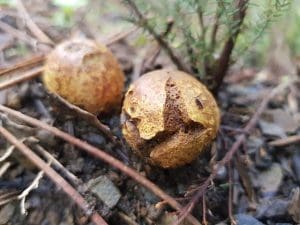
Smell:
Mushroomy but not pleasant.
Spores:
Creamy white.
Known hazards
Most books list them as inedible, a few say edible but not worthwhile, they’re not a species that we recommend.
Potential lookalikes
They do look a bit like a truffle but they are not related. In fact the False truffle is related to the Bolete’s. The native species of truffle in the UK, Tuber uncinatum and Tuber aestivum are a lot darker in colour and grow underground. Their skins are covered in pyramid shaped warts which the False truffle lacks.
I think you’d be more likely to confuse them with an Earthball (Scleroderma citrinum) or some Puffballs (Lycoperdon). Earthballs when mature has an interior that is purple to black and their skin is thicker. Earthballs are toxic and should also be avoided. Puffballs tend to be lighter in colour and their interiors are softer, spongier and paler.
Extra Notes from the Foragers
The name Rhizopogon, comes from Rhiz- meaning root, and -pogon, meaning beard in Greek.
Native to Europe, it’s found a lot in Australia, it was used as a soil inoculant to improve yields at pine plantations and has found its way into the wild.
As well as being in a symbiotic relationship with Pine trees, they are also in a relationship with rodents. False truffles don’t have the ability to spread its own spores and depends on rodents to help do this. The rodents are attracted to a scent produced by the false truffle and ingest the spores and deposit them later.
References:
https://www.first-nature.com/fungi/rhizopogon-luteolus.php



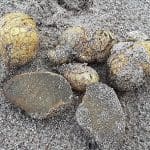
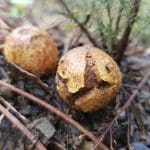
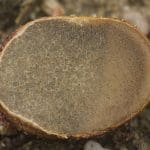
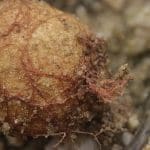



Leave a Reply
You must be logged in to post a comment.